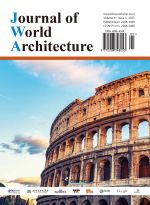Application of Self-Healing Concrete in Sustainable Architecture: Mechanisms, Performance, and Future Prospects
Abstract
The construction industry faces significant challenges due to the inherent brittleness and cracking tendency of traditional concrete, which compromises structural durability and necessitates frequent, costly repairs. This paper explores the groundbreaking development of self-healing concrete as a transformative material technology for sustainable architecture. We examine three primary autogenous healing mechanisms: encapsulated polymer/microbial healing agents, vascular networks, and shape memory alloys. Through a review of recent laboratory experiments and pilot projects, this study analyzes the crack-sealing efficiency, recovery of mechanical properties, and long-term durability of these materials. A comparative case study of a demonstration building facade incorporating microbial self-healing concrete is presented, showing a potential 30% reduction in maintenance costs over a 20-year lifecycle. The findings indicate that self-healing concrete not only enhances structural resilience but also significantly reduces the carbon footprint associated with building maintenance, aligning with the core principles of sustainable development. The paper concludes by discussing current limitations in mass production and cost-effectiveness and proposes directions for future research to facilitate widespread adoption in architectural engineering.
References
Wang X, Huang Y, Zhang L, 2022, Microencapsulation Technology for Self-Healing Concrete: A Review. Construction and Building Materials, 325: 126667.
Van Tittelboom K, De Belie N, 2013, Self-Healing in Cementitious Materials—A Review. Materials, 6(6): 2182–2217.
Li VC, Herbert E, 2012, Robust Self-Healing Concrete for Sustainable Infrastructure. Journal of Advanced Concrete Technology, 10(6): 207–218.
Wiktor V, Jonkers HM, 2011, Quantification of Crack-Healing in Novel Bacteria-Based Self-Healing Concrete. Cement and Concrete Composites, 33(7): 763–770.
Dry C, 2000, Three Designs for the Internal Release of Sealants, Adhesives, and Waterproofing Chemicals into Concrete to Reduce Permeability. Cement and Concrete Research, 30(12): 1969–1977.
Snoeck D, Van Tittelboom K, Steuperaert S, et al., 2014, Self-Healing Cementitious Materials by the Combination of Microfibres and Superabsorbent Polymers. Journal of Intelligent Material Systems and Structures, 25(1): 13–24.
Wang JY, Soens H, Verstraete W, et al., 2014, Self-Healing Concrete by Use of Microencapsulated Bacterial Spores. Cement and Concrete Research, 56: 139–152.

